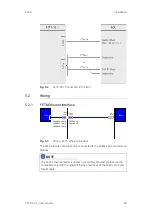
ETAS
Hardware Description
FETK-S2.1 - User’s Guide
23
4.6
Data Emulation and Data Measurement
The FETK-S2.1 is a serial FETK using JTAG as the primary microcontroller
interface. The interface can switch to LFAST during handshake. Typical of all
serial ETKs, XETKs and FETKs,the RAM used for data emulation and data mea-
surement is not accessible by the FETK until the microcontroller is powered up
and the startup handshake is performed.
Serial FETKs use the ETAS two page concept, consisting of both a Reference
and a Working page.
The Reference Page is located in the ECU flash and can not be modified by a
simple write access. All changes to the Reference Page must be done via Flash
programming.
The Working Page is located within the microcontroller's ED RAM. The Working
Page may be a portion of or the entire size of the ED RAM. The ED RAM used
for the emulation of calibration data must not be used by the ECU software
directly as general purpose RAM. It is recommended that the ED RAM is perma-
nently powered by the FETK or ECU. The FETK/INCA has the complete control
over the RAM used as Working Page and it's contents. When enabling data
emulation, the FETK establishes a basic start-up configuration of the data in
the Working Page by copying the corresponding data in the Flash to the emula-
tion space.
To enable calibration, the Working Page must be activated. The process of
switching from the Reference Page to the Working Page and vice versa is
known as page switching.
The FETK-S2.1 supports Protocol Based page switching for all supported
microcontrollers. Page switching is done in microcontroller software by switch-
ing the overlay memory on (Working Page) and off (Reference Page) using
microcontroller overlay registers. The FETK-S2.1 does not directly control the
microcontroller overlay registers. Instead the FETK-S2.1 and microcontroller
software use a simple communication method with a shared mailbox in RAM.
The FETK uses this mailbox to request and monitor page switching; the micro-
controller software is responsible to service this mailbox and perform the page
switches. Using an overlay modification description, also in RAM, the FETK pro-
vides the necessary information of how the overlay registers need to be modi-
fied to realize the page switch which is requested.
The FETK-S2.1 can access both the Reference Page and the Working Page,
regardless of which is active from the microcontroller’s point of view.
Another important restriction is that no access to the memory is possible, while
the ECU is not running. To enable a cold start measurement in spite of this
restriction, the cold start measurement procedure is defined to give the user
the feeling of a parallel FETK.
















































